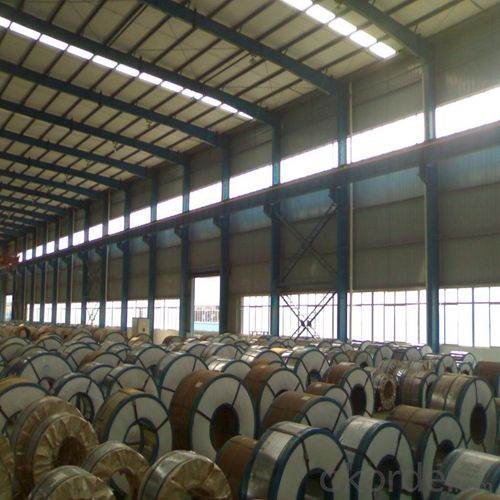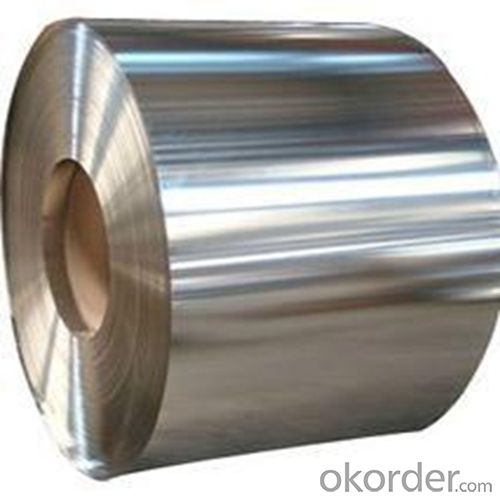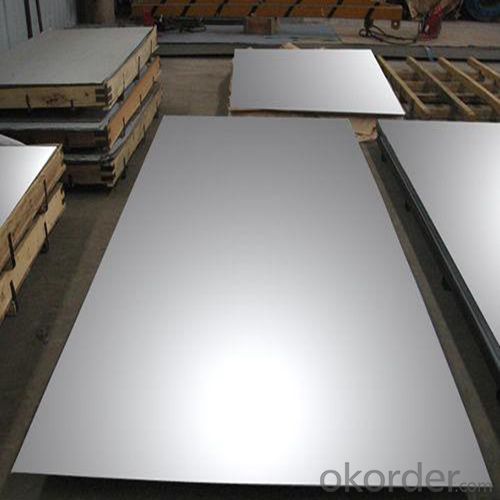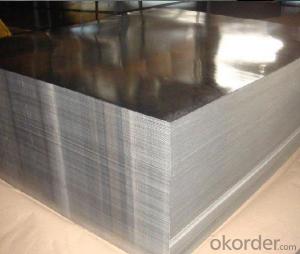Prime Quality Electrolytic Tinplate Sheets or Coils in Low Price
- Loading Port:
- Tianjin
- Payment Terms:
- TT or LC
- Min Order Qty:
- 25 m.t.
- Supply Capability:
- 7000 m.t./month
OKorder Service Pledge
OKorder Financial Service
You Might Also Like
1.Electrolytic tinplate (ETP) sheets in low price Description
Electrolytic Tin Plate Coils and Sheets for Foods Metal Packaging, is one thin steel sheet with a coating of tin applied by electrolytic deposition. Tinplate made by this process is essentially a sandwich in which the central core is strip steel. This core is cleaned in a pickling solution and then fed through tanks containing electrolyte, where tin is deposited on both sides. As the strip passes between high-frequency electric induction coils, it is heated so that the tin coating melts and flows to form a lustrous coat.
2.Main Features of the Electrolytic tinplate (ETP) sheets in low price
Steady and high quality
Fast shipment
Good experience for export work
For the surface, Plate uniform in thickness,uniform and smooth tin coating, without flaws,rusts,scratch,wave,nick of tin coating etc.
Price competitive
3.Electrolytic tinplate (ETP) sheets in low price Images



4.Electrolytic tinplate (ETP) sheets in low price Specification
Standard | ISO 11949 -1995, GB/T2520-2000,JIS G3303,ASTM A623, BS EN 10202
|
Material | MR,SPCC |
Thickness | 0.15mm - 0.50mm |
Width | 600mm -1150mm |
Temper | T1-T5 |
Annealing | BA & CA |
Coil Inner Diameter | 508mm |
Weight | 6-10 tons/coil 1~1.7 tons/sheets bundle |
Passivation | 311 |
Oil | DOS |
Surface | Finish,bright,stone,matte,silver |
5.FAQ of Electrolytic tinplate (ETP) sheets in low price
-How to place .an order or contact you ?
Please send us Email. we will give you a quick response in seconds .
- How is your quality ?
All our quality is prime even the secondary quality . We have many years experience
In this field with serious quality control standard . Advanced equipment, We welcome your visit to our factory .
- Q:What are the common decorative options for tinplate packaging?
- Some common decorative options for tinplate packaging include embossing, lithography, and spot varnishing. Embossing involves creating raised designs on the surface of the tinplate, adding texture and visual interest. Lithography is a printing technique that allows for vibrant colors and intricate designs to be applied to the tinplate. Spot varnishing is a method of selectively applying a glossy finish to certain areas of the packaging, creating a contrasting effect. These decorative options can enhance the overall aesthetic appeal of tinplate packaging and make it more visually appealing to consumers.
- Q:Tin can bake oven electrical electromagnetic induction principle
- First of all, you know that mechanical energy such as sound can not be transmitted in a vacuum, but it can propagate electromagnetic waves. Heating iron cans, iron cans emit electromagnetic waves, infrared, and the like. The bottle is left vacant or left vacant, and it will be affected by energy, fever, deformation and so on.
- Q:What are the main growth opportunities for the tinplate industry?
- The main growth opportunities for the tinplate industry include the increasing demand for packaged food and beverages, the rising popularity of sustainable packaging solutions, and the growing automotive sector requiring tinplate for various applications. Additionally, emerging markets and technological advancements in tinplate production processes offer significant growth potential for the industry.
- Q:How is tinplate used in the beverage industry?
- Tinplate is commonly used in the beverage industry for packaging cans due to its ability to provide a protective barrier against corrosion and maintain the flavor and quality of the beverages.
- Q:How does tinplate handle exposure to UV radiation?
- Tinplate does not handle exposure to UV radiation well as it tends to corrode and degrade over time when exposed to sunlight.
- Q:Can tinplate be used for non-packaging applications?
- Yes, tinplate can be used for non-packaging applications. Tinplate's properties such as durability, corrosion resistance, and versatility make it suitable for various non-packaging uses such as automotive parts, electrical components, construction materials, and more.
- Q:How does tinplate contribute to sustainable packaging?
- Tinplate contributes to sustainable packaging as it is 100% recyclable and can be reused indefinitely without losing its properties. It also provides excellent barrier properties, protecting the contents from light, oxygen, and moisture, thus extending the shelf life of the packaged products. Additionally, tinplate is lightweight, reducing transportation costs and emissions.
- Q:How does tinplate handle exposure to different atmospheric conditions?
- Tinplate generally handles exposure to different atmospheric conditions quite well. Its corrosion resistance, thanks to the tin coating, helps protect the underlying steel from rusting and other forms of degradation. However, extreme conditions such as high humidity, acidic environments, or prolonged exposure to saltwater may still pose some risk. In such cases, additional protective measures like coatings or proper maintenance are recommended to ensure the tinplate's longevity.
- Q:How is tinplate recycled and what are its recycling rates?
- Tinplate is recycled through a process called "tinplate recycling" where it is collected, sorted, and melted down to create new products. The recycling rates of tinplate vary depending on factors such as regional recycling infrastructure, collection efforts, and consumer awareness. However, on average, tinplate has a relatively high recycling rate of around 80-90% in many developed countries.
- Q:How does tinplate affect the environment?
- Tinplate can have both positive and negative impacts on the environment. On one hand, tinplate is a highly recyclable material, which helps reduce waste and conserve resources. It can be recycled multiple times without losing its quality, making it an environmentally friendly choice. On the other hand, the production of tinplate involves energy-intensive processes and can result in the emission of greenhouse gases. Additionally, the mining of tin, one of the main components of tinplate, can have adverse effects on ecosystems and local communities. Therefore, while tinplate offers recycling benefits, its production and sourcing should be done responsibly to minimize its environmental impact.
1. Manufacturer Overview |
|
|---|---|
| Location | |
| Year Established | |
| Annual Output Value | |
| Main Markets | |
| Company Certifications | |
2. Manufacturer Certificates |
|
|---|---|
| a) Certification Name | |
| Range | |
| Reference | |
| Validity Period | |
3. Manufacturer Capability |
|
|---|---|
| a)Trade Capacity | |
| Nearest Port | |
| Export Percentage | |
| No.of Employees in Trade Department | |
| Language Spoken: | |
| b)Factory Information | |
| Factory Size: | |
| No. of Production Lines | |
| Contract Manufacturing | |
| Product Price Range | |
Send your message to us
Prime Quality Electrolytic Tinplate Sheets or Coils in Low Price
- Loading Port:
- Tianjin
- Payment Terms:
- TT or LC
- Min Order Qty:
- 25 m.t.
- Supply Capability:
- 7000 m.t./month
OKorder Service Pledge
OKorder Financial Service
Similar products
New products
Hot products
Hot Searches
Related keywords




























